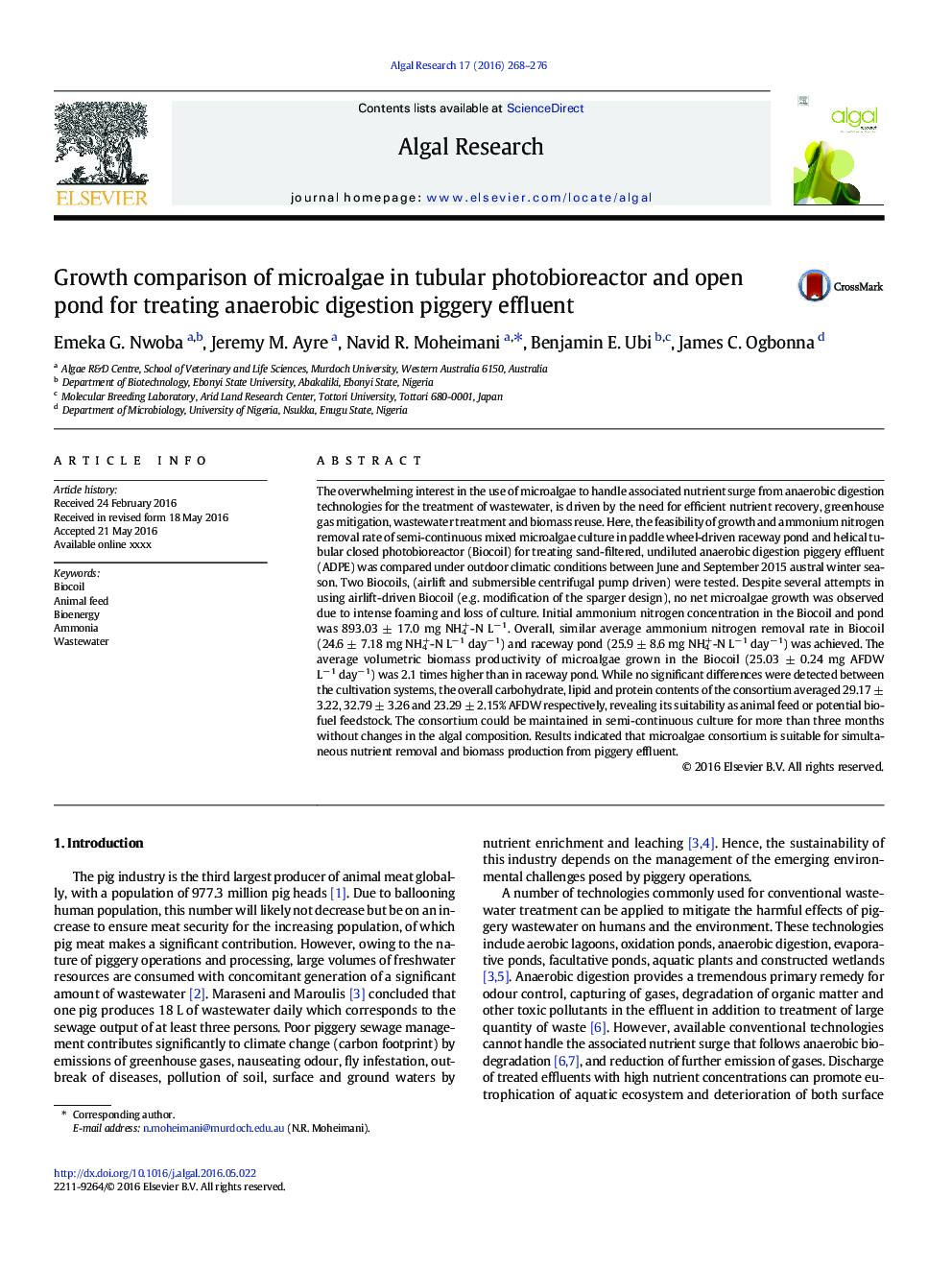| کد مقاله | کد نشریه | سال انتشار | مقاله انگلیسی | نسخه تمام متن |
|---|---|---|---|---|
| 8086847 | 1521815 | 2016 | 9 صفحه PDF | دانلود رایگان |
عنوان انگلیسی مقاله ISI
Growth comparison of microalgae in tubular photobioreactor and open pond for treating anaerobic digestion piggery effluent
ترجمه فارسی عنوان
مقایسه رشد مایکروویو در فتو بیوراکتور لوله ای و حوضچه باز برای درمان فاضلاب هگزا بی هوازی
دانلود مقاله + سفارش ترجمه
دانلود مقاله ISI انگلیسی
رایگان برای ایرانیان
کلمات کلیدی
موضوعات مرتبط
مهندسی و علوم پایه
مهندسی انرژی
انرژی های تجدید پذیر، توسعه پایدار و محیط زیست
چکیده انگلیسی
The overwhelming interest in the use of microalgae to handle associated nutrient surge from anaerobic digestion technologies for the treatment of wastewater, is driven by the need for efficient nutrient recovery, greenhouse gas mitigation, wastewater treatment and biomass reuse. Here, the feasibility of growth and ammonium nitrogen removal rate of semi-continuous mixed microalgae culture in paddle wheel-driven raceway pond and helical tubular closed photobioreactor (Biocoil) for treating sand-filtered, undiluted anaerobic digestion piggery effluent (ADPE) was compared under outdoor climatic conditions between June and September 2015 austral winter season. Two Biocoils, (airlift and submersible centrifugal pump driven) were tested. Despite several attempts in using airlift-driven Biocoil (e.g. modification of the sparger design), no net microalgae growth was observed due to intense foaming and loss of culture. Initial ammonium nitrogen concentration in the Biocoil and pond was 893.03 ± 17.0 mg NH4+-N Lâ 1. Overall, similar average ammonium nitrogen removal rate in Biocoil (24.6 ± 7.18 mg NH4+-N Lâ 1 dayâ 1) and raceway pond (25.9 ± 8.6 mg NH4+-N Lâ 1 dayâ 1) was achieved. The average volumetric biomass productivity of microalgae grown in the Biocoil (25.03 ± 0.24 mg AFDW Lâ 1 dayâ 1) was 2.1 times higher than in raceway pond. While no significant differences were detected between the cultivation systems, the overall carbohydrate, lipid and protein contents of the consortium averaged 29.17 ± 3.22, 32.79 ± 3.26 and 23.29 ± 2.15% AFDW respectively, revealing its suitability as animal feed or potential biofuel feedstock. The consortium could be maintained in semi-continuous culture for more than three months without changes in the algal composition. Results indicated that microalgae consortium is suitable for simultaneous nutrient removal and biomass production from piggery effluent.
ناشر
Database: Elsevier - ScienceDirect (ساینس دایرکت)
Journal: Algal Research - Volume 17, July 2016, Pages 268-276
Journal: Algal Research - Volume 17, July 2016, Pages 268-276
نویسندگان
Emeka G. Nwoba, Jeremy M. Ayre, Navid R. Moheimani, Benjamin E. Ubi, James C. Ogbonna,
